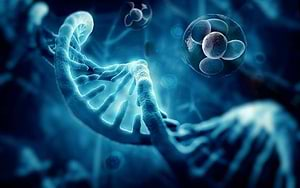A research team has discovered for the first time variants at a single site in the genome which increase the risk of developing erectile dysfunction (ED). This significant discovery may lead the way for developing novel genetic-based therapies to restore erectile function.
ED is the persistent inability to achieve or maintain an erection sufficient for sexual intercourse. It is a common disorder affecting mostly men over 40, associated with vascular, hormonal and neural factors, including conditions such as type 2 diabetes, heart and blood vessel disease, chronic kidney disease, obesity, among others. Although the currently available ED treatments work at least partially on these factors, not all men respond to them adequately. However recently, a new study identified a genetic factor associated with the development of ED which could lead to novel efficacious genetic treatments.
What makes this study unique?
Traditionally, studies which examined the effect of heredity on a specific trait or disease development were based on twins’ and families’ models.
Although earlier studies of middle-aged male twins have demonstrated that at least one third of ED risk is heritable, until now scientists had never been able to locate a site in the genome that confers this risk.
However, the development of new genetic mapping methods and the establishment of genetic databases, have enabled researchers in 2018 to analyze the genomes of nearly a quarter of a million men, and to discover for the first time that variants at a single site on Chromosome 6 significantly increase the risk of developing ED.
The new research is a Genome-Wide Association (GWA) study – which is used to identify genomic variants associated with a risk for a disease or a particular trait in large groups of individuals.
How is it conducted? The entire human DNA sequence is made of over 3 billion building-blocks composed of 4 different bases (molecules), marked as: A, T, C, G. However, when we look at DNA sequences in the general population, we may discover that a certain percentage of the population has a variation at a single base position in the DNA. (For example, one has the bases in the order A, T, C, G and another person has them in the order of AGCT because he has an inversion in that). These variations are called Simple Single Nucleotide Polymorphisms, or SNPs and they refer to the genetic differences in and among populations.
GWAS are studies that are based on locating specific SNIPs (genetic variants) among people with a certain trait or health problem.
What did the study find?
As mentioned, this GWA study focused on identifying SNIPs among men with ED. For this purpose, the investigators analyzed DNA samples of a racially diverse cohort comprising 36,649 men, of which 14,215 men reported ED symptoms. The characteristics of the latter group (compared to the control group of 22,434 men), were: older age, a slightly higher body mass index (a measure of weight relative to height), having diabetes, being smokers or former smokers, having a clinical diagnosis of ED. The surprising finding was that in the group of men with ED, the investigators found DNA sequences with SNIPs in a specific location on chromosome 6, adjacent to the gene SIM1 – which is part of a biological pathway regulating sexual function and body weight. The bottom line is that these SNIPs were associated with a 26% increase in the risk of ED.
The results were later confirmed in a second study cohort of 222,358 men, who had ED and the same SNIPs. It is noteworthy, that the genetic increased risk of developing ED is independent of other ED risk factors (such as high BMI, diabetes, enlarged prostate, high cholesterol, smoking and cardiovascular problems). This fact indicates that the genetic site on chromosome 6, adjacent to the SIM1 gene, is directly related to a previously unknown mechanism of sexual function in men.
About the importance of the research
This new discovery is highly significant because it finally provides the long sought-after proof – that there is a genetic component to ED. Furthermore, it opens the door for investigations into new, genetic-based therapies, that could be used to treat the 50% of men who do not respond to the currently available ED treatments or those who discontinue treatments due to side effects. Genetic research will focus on the SIM1 gene, restoring erectile function and helping men achieve a healthy sex life. However, it’s important to remember that lifestyle related risk factors such as obesity, smoking and diabetes are still primary reasons for developing ED. The research now shows that for certain individuals the risk is even higher due to genetic variations.
The investigators speculate that the findings may also have implications for women, as earlier research has shown that the same biological pathway implicated in the new study is likewise associated with the sexual desire and arousal in females.
The Company hereby clarifies that the information contained on the website is for informational purposes only, and is not intended to be a substitute for professional medical and healthcare advice, and does not constitute medical advice or opinion. Always seek the advice of your physician or other qualified health provider with any medical condition or question you may have regarding a medical condition.





